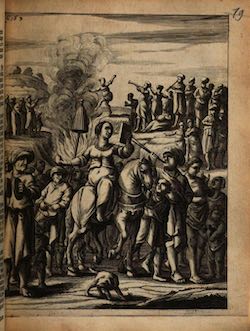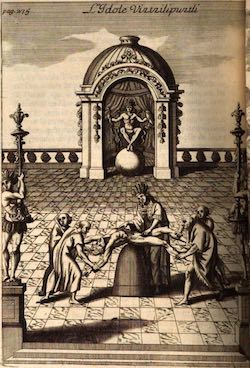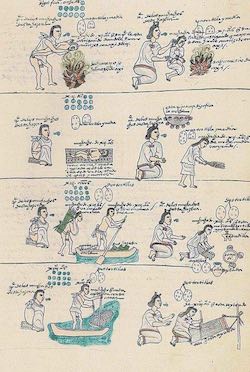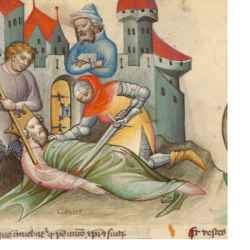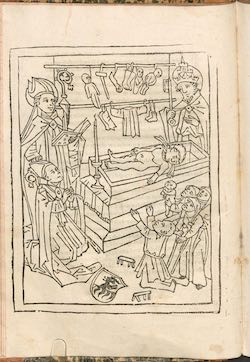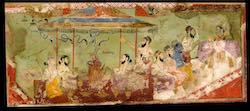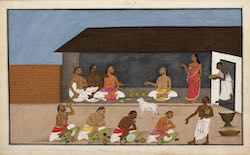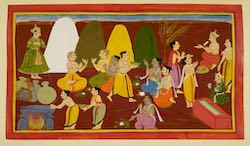Topic: 2. Sacrifice and religion: Comparisons, Antiquarians, Anthropology (16th-18th Century)
Religious sacrifices across various cultures and contexts sparked widespread interest in Early Modern Europe. As Christianity expanded into regions inhabited by "infidels" and "pagans", Europeans encountered a diverse array of sacrificial customs, ranging from the Sati rituals in India to the Aztec sacrifices in the Americas. This cross-cultural exposure captivated a wide audience, including theologians, philosophers, political thinkers, antiquarians, orientalists, missionaries, poets, artists, and even the general public. These encounters broadened the European understanding of sacrifice and led to a critical reassessment of classical and biblical sacrificial rites. This section includes:
- Sources: A selection of early modern printed materials, which include descriptions of the Americas, Asia, and Africa, alongside antiquarian and philological studies on religious sacrifice in classical antiquity and beyond. It also presents early modern works of ethnological observations and the first attempts to compare different sacrificial practices in various traditions and contexts, laying the groundwork for disciplines like the history of religions and anthropology.
- Iconographic Representations: A rich collection of images from the 16th to 18th centuries, illustrating a range of sacrificial rituals and practices as seen in different cultural and geographical contexts.
- Related Bibliography: An extensive bibliography spanning scholarly works from the 19th to 21st centuries, providing contemporary analyses and interpretations of these early studies and observations.
Scene of a sati. In the foreground, a widowed woman (encountered by Della Valle on November 12, 1623) on horseback holds a mirror and a lemon amidst a crowd. In the background, a woman throws herself into the flames of a funeral pyre (1665)
from: Della Valle, Pietro, De volkome beschryving der voortreffelijke reizen van de deurluchtige reisiger Pietro della Valle, edelman van Romen, in veel voorname gewesten des werrelts, sedert het jaer 1615, tot in 't jaar 1626 gedaan. Amsterdam, Abraham Wolfgang, 1666, vol. 5, pag. 163
Scene of cow sacrifice on a relief brass plaques (16th-17th)
from: Benin City, Nigeria
British Museum, London
Scene of worship and human sacrifice at a native American or Mexican temple (1691)
from: Antonio de Solís y Rivadeneira, Histoire de la conquête du Mexique, ou de la Nouvelle Espagne, Paris, Boudot, 1691. p. 275
Self-sacrifice of King Codrus of Athens (1432)
from: Speculum humanae salvationis, Madrid, Biblioteca Nacional de España, Ms Vit. 25-7 (olim B. 19), fol. 24r
Biblioteca Nacional de España, Madrid
Simon of Trent’s corpse (“victima”) (1475)
from: Historie von Simon zu Trient [Bayerische StaatsBibliothek, 2 Inc.s.a. 62#Beibd], fol. 5v
Bayerische Staatsbibliothek, Munich
Simon on the altar (“victima”) (1475)
from: Historie von Simon zu Trient [Bayerische StaatsBibliothek, 2 Inc.s.a. 62#Beibd], fol. 9v
Bayerische Staatsbibliothek, Munich
Snake Sacrifice [1690]
from: Udaipur, Rajasthan state, Mewar, India
Henri Vever Collection, Freer|Sackler gallery at the Smithsonian Institution
Suttee (1878)
from: Murray Smith, D. Round the World: A Story of Travel Compiled from the Narrative of Ida Pfeiffer, London, 1878
http://www.columbia.edu/itc/mealac/pritchett/00routesdata/1800_1899/hinduism/sati/sati.html
Suttee Pillar at a Benares Burning Ghat (19th century)
http://www.columbia.edu/itc/mealac/pritchett/00routesdata/1800_1899/hinduism/sati/sati.html
Sutteeism on the Banks of the Ganges (1860)
from: Montgomery Martin, R. The Indian Empire, c.1860
http://www.columbia.edu/itc/mealac/pritchett/00routesdata/1800_1899/hinduism/sati/sati.html
The Aztec day sign tecpatl (flint) [1501 - 1600]
from: Codex Magliabecchiano
Biblioteca Nazionale di Firenze, Florence
The Ekahum ceremony, consisting of the release of a bull. A young bull stands in the courtyard of the deceased's house. His eldest son performs a sacrifice with rice, plantains and three brass pots of water decorated with mango leaves. The widow is dressed in her finest clothes and a feast is given to the Brahmins (ca 1820)
from: The Lives of the Brahmins [Ms Add.Or. 4354]
British Library, London
The feast before the sacrifice (1712)
from: Ramayana, Bala Kanda, Ms Add. 15295, fol. 31
British Library, London [from Udaipur]
The Funeral Pile of a Husband (1810)
http://www.columbia.edu/itc/mealac/pritchett/00routesdata/1800_1899/hinduism/sati/sati.html

